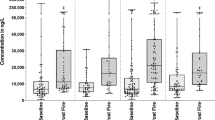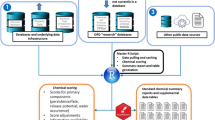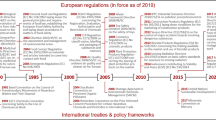Abstract
Background
Human biomonitoring (HBM) has been repeatedly recommended for and applied to post-incident chemical exposure assessment. The applicability of HBM and the validity of its results, however, closely depend on the existence and quality of preparatory measures such as information and instruction materials, sampling procedures, transport and storage facilities, and on the selection of appropriate biomarkers, sampling time, transport and storage conditions.
Objective
To establish a standardized HBM program for emergency responders of a large chemical production site, considering the aforementioned aspects.
Methods
An HBM program based on a comprehensive questionnaire, information and training of emergency responders, and availability of sampling material was established. The quantitative determination of metabolites of hazardous substances was carried out based on quality-controlled analytical methods.
Results
The use of HBM after emergency operations was significantly increased immediately after the implementation of the program. Only in single cases, however, established HBM assessment values were exceeded. After one major incident, an increased exposure to benzene exceeding the internal action value was observed after firefighting and safeguarding.
Significance
The experience with several minor and one major incident at a chemical production site suggests that the implementation of easily accessible and applicable routines is one paramount prerequisite for the success of HBM programs after chemical incidents.
This is a preview of subscription content, access via your institution
Access options
Subscribe to this journal
Receive 6 print issues and online access
$259.00 per year
only $43.17 per issue
Buy this article
- Purchase on Springer Link
- Instant access to full article PDF
Prices may be subject to local taxes which are calculated during checkout


Similar content being viewed by others
References
IARC—International Agency for Research on Cancer. IARC Monographs on the evaluation of carcinogenic risks to humans: painting, firefighting, and shiftwork, vol 98. Lyon, France: World Health Organization; 2010.
Fritschi L, Glass DC. Firefighters and cancer: where are we and where to now? Occup Environ Med. 2014;71:525–6.
Tsai RJ, Luckhaupt SE, Schumacher P, Cress RD, Deapen DM, Calvert GM. Risk of cancer among firefighters in California, 1988-2007. Am J Ind Med. 2015;58:715–29.
Kullberg C, Andersson T, Gustavsson P, Selander J, Tornling G, Gustavsson A, et al. Cancer incidence in Stockholm firefighters 1958-2012: an updated cohort study. Int Arch Occup Environ Health. 2018;91:285–91.
Jalilian H, Ziaei M, Weiderpass E, Rueegg CS, Khosravi Y, Kjaerheim K. Cancer incidence and mortality among firefighters. Int J Cancer. 2019;145:2639–46.
Soteriades ES, Kim J, Christophi CA, Kales SN. Cancer incidence and mortality in firefighters: a state-of-the-art review and meta-analysis. Asian Pac J Cancer Prev. 2019;20:3221–31.
Casjens S, Brüning T, Taeger D. Cancer risks of firefighters: a systematic review and meta-analysis of secular trends and region-specific differences. Int Arch Occup Environ Health. 2020;93:839–52.
Decker JA, DeBord DG, Bernard B, Dotson S, Halpin J, Hines CJ, et al. Recommendations for biomonitoring of emergency responders: focus on occupational health investigations and occupational health research. Mil Med. 2013;178:68–75.
Scheepers PTJ, van Brederode NE, Bos PMJ, Nijhuis NJ, van de Weerdt RHJ, van der Woude I, et al. Human biological monitoring for exposure assessment in response to an incident involving hazardous materials. Tox Lett. 2014;231:295–305.
Müller M, Schmiechen K, Heselmann D, Schmidt L, Göen T. Human biological monitoring—a versatile tool in the aftermath of an CBRN incident. Tox Lett. 2014;231:306–14.
Smolders R, Colles A, Cornelis C, Van Holderbeke M, Chovanova H, Wildemeersch D, et al. Key aspects of a Flemish system to safeguard public health interests in case of chemical release incidents. Tox Lett. 2014;231:315–23.
GHS/CLP (2008) Harmonized classification—annex VI of regulation (EC) No 1272/2008 (Classification, Labelling and Packaging) epichlorohydrin. https://echa.europa.eu/de/information-on-chemicals/cl-inventory-database/-/discli/details/107704. (last retrieved 27/10/2020)
Wollin KM, Bader M, Müller M, Lilienblum W, Csicsaky M. Assessment of long-term health risks after accidental exposure using haemoglobin adducts of epichlorohydrin. Toxicol Lett. 2014;231:378–86.
Bader M, Rosenberger W, Gutzki FM, Tsikas D. Analysis of N-(3-chloro-2-hydroxypropyl)valine in human haemoglobin as a biomarker of epichlorohydrin exposure by gas chromatography—negative chemical ionisation mass spectrometry with collision-induced dissociation and selected reaction monitoring. J Chrom B. 2009;877:1402–15.
Bader M, Wrbitzky R, Rosenberger W, Gutzki FM, Tsikas D, Stichtenoth DO, et al. Determination of protein adducts as biomarkers of accidental exposure to 1-chloro-2,3-epoxypropane (epichlorohydrin)—results of a biomonitoring study and risk assessment of long-term health effects. Oral presentation. Proceedings of the 29th International Congress on Occupational Health (ICOH), Cape Town, South Africa, 2009.
HBM-UBA. Kommission Human-Biomonitoring—Umweltbundesamt: Empfehlungen zum Einsatz von Human-Biomonitoring bei einer störfall-oder unfallbedingten Freisetzung von Chemikalien mit Exposition der Bevölkerung. Bundesgesundheitsbl Gesundheitsforsch Gesundheitsschutz. 2006;49:704–12.
Müller M, Schmiechen K. Humanbiomonitoring im Bevölkerungsschutz. Forschung im Bevölkerungsschutz, Band 16. Bonn, Germany: Bundesamt für Bevölkerungsschutz und Katastrophenhilfe; 2012.
Eggens ML, Bos PMJ, Grievink L, Nijhuis NJ, Scheepers PTJ, van de Weerdt DHJ, et al. Environmental health guideline for municipal health services: human biomonitoring for small scale chemical incidents. RIVM Report 609300023, 2012. http://www.rivm.nl/Bibliotheek/Wetenschappelijk/Rapporten/2012/april/GGD richtlijn medische milieukunde - HBM bij kleinschalige chemische incidenten, Bilthoven, The Netherlands (last retrieved 27/10/2020)
Scheepers PT, Bos PM, Konings J, Janssen NA, Grievink L. Application of biological monitoring for exposure assessment following chemical incidents: a procedure for decision making. J Expo Sci Environ Epidemiol. 2011;21:247–61.
BauA—Bundesanstalt für Arbeitsschutz und Arbeitsmedizin (Federal Institute of Occupational Safety and Health). Biomonitoring Laboratories. https://www.baua.de/EN/Topics/Work-design/Hazardous-substances/Biomonitoring/Biomonitoring-Laboratories/Biomonitoring-Laboratories_node.html. 2020.
Bader M, Van Weyenbergh T, Verwerft E, Van Pul J, Lang S, Oberlinner C. Human biomonitoring after chemical incidents and during short-term maintenance works as a tool for exposure analysis and assessment. Tox Lett. 2014;231:328–36.
Deutsche Forschungsgemeinschaft (DFG). The MAK collection for occupational health and safety. Documentation and methods. https://series.publisso.de/en/pgseries/overview/mak/dam. 2020. (open access)
WHO—World Health Organization. Biological monitoring of chemical exposure in the workplace, vol. 1. Geneva: World Health Organization; 1996.
Bader M, Ochsmann E. Addendum to creatinine as reference parameter for the concentration of substances in urine. In: The MAK collection for occupational health and safety, vol. 1. DFG Deutsche Forschungsgemeinschaft; 2016. p. 266–8.
Kraus T, Bader M, Klotz K, Weistenhöfer W, Drexler H, Hartwig A, et al. Addendum to benzene. The MAK collection for occupational health and safety, vol. 4. Weinheim, Germany: Wiley-VCH Verlag; 2019. p. 200–32. https://doi.org/10.1002/3527600418.bb7143e2319.
ACGIH—American Conference of Governmental Hygienists. Benzene. Documentation of the TLV® and BEI® values. Cincinnati, OH: Signature Publications; 2001.
Van Nieuwenhuyse A, Fierens S, De Smedt T, De Cremer K, Vleminckx C, Mertens B, et al. Acrylonitrile exposure assessment in the emergency responders of a major train accident in Belgium: a human biomonitoring study. Tox Lett. 2014;231:352–9.
Acknowledgements
The authors thank all participants of the voluntary HBM program for emergency responders for their collaboration. The work presented in this paper is part of the occupational medical exposure assessment and of emergency response.
Funding
The analyses and other works described in this paper are part of the occupational medical services in the company and on the production site. No additional funding was received.
Author information
Authors and Affiliations
Corresponding author
Ethics declarations
Conflict of interest
The authors are employees of a chemical company. The authors declare no competing interests.
Additional information
Publisher’s note Springer Nature remains neutral with regard to jurisdictional claims in published maps and institutional affiliations.
Rights and permissions
About this article
Cite this article
Bader, M., Bäcker, S., Jäger, T. et al. Preparedness as a key factor for human biomonitoring programs after chemical incidents. J Expo Sci Environ Epidemiol 31, 867–875 (2021). https://doi.org/10.1038/s41370-021-00320-w
Received:
Revised:
Accepted:
Published:
Issue Date:
DOI: https://doi.org/10.1038/s41370-021-00320-w
Keywords
This article is cited by
-
A “dilute-and-shoot” column-switching UHPLC–MS/MS procedure for the rapid determination of branched nonylphenol in human urine: method optimisation and some fundamental aspects of nonylphenol analysis
Analytical and Bioanalytical Chemistry (2023)
-
Exposure science perspective on disaster preparedness and resilience
Journal of Exposure Science & Environmental Epidemiology (2021)



